| Pages:
1
2 |
sabbath06
Harmless

Posts: 10
Registered: 17-8-2010
Member Is Offline
Mood: No Mood
|
|
NO2 ventilation in HNO3 distillation
I finally have all the pieces to my distillation setup and would like to prepare concentrated nitric acid from concentrated sulfuric acid and
potassium nitrate. I do not have a fume hood and was wondering if I would be okay connecting some tubing to the vacuum adapter and leading the
nitrogen dioxide into a solution of sodium hydroxide. Assuming that all 24/40 joints are sealed with vacuum grease and clamps, can I expect that no
other nitrogen dioxide would escape? Would doing it by a window with a fan drawing air out provide enough ventilation? Performing the reaction
outdoors isn't really an option right now.
Also, will my thermometer adapter that holds the thermometer in place with a rubber o-ring survive or will I need to acquire a Teflon one?
[Edited on 12-2-2011 by vulture]
|
|
|
hkparker
National Hazard
   
Posts: 601
Registered: 15-10-2010
Location: California, United States
Member Is Offline
Mood: No Mood
|
|
Ive done that with sodium carbonate, no good, if the apparatus loses pressure then it sucks back solution into the product with the violent evolution
of NO2. I did this on my video on this on youtube. When I shot the video it didnt happen, on another attempt it was dramatic.
Use urea granules. Have the tube lead to the bottom of a beaker full of urea. That will catch NO2 very effectively, and can't be sucked back. Still
work with an open window or fan, and ideally outside though I know you said its not an option atm.
Also rubber? Teflon? I would only ever use glass, its HNO3 gas. Now I can't say for sure that it will attack teflon but I wouldnt use a thermometer
in the apparatus, instead monitor the heat of the oil bath if you cant use a glass adapter.
Hope that helps.
My YouTube Channel
"Nothing is too wonderful to be true if it be consistent with the laws of nature." -Michael Faraday
|
|
|
not_important
International Hazard
    
Posts: 3873
Registered: 21-7-2006
Member Is Offline
Mood: No Mood
|
|
Alternatively use a suck-back bottle, an empty bottle between collector and absorber. The connection to the collector is short or just the top ground
glass joint, the one to the absorber can have a tube leading nearly to the bottom of suck-back prevention bottle/flask.
Plain organic vac greases will be attacked by hot HNO3/NO2, fluorocarbon and many silicone types (but not all) are OK. Teflon is OK, but the white
plumbers teflon tape is fairly porous and is mean to be squeezed down between pipe threads; using as a glassware seal is problematic.
|
|
|
jamit
Hazard to Others
  
Posts: 375
Registered: 18-6-2010
Location: Midwest USA
Member Is Offline
Mood: No Mood
|
|
hey congratulation on acquiring a distillation set! I've made nitric acid but outside and I've used baking soda solution to neutralize the no2 gas
from the vacuum adapter.
I agree with Hkparker, you don't need the thermometer so long as you monitor the heating element. I used an oil bath just like hkparker. Keep the
temperature between 160-190 C and you should be fine.
If you "must" do it indoors, try it on a small scale before attempt anything on a large scale. make sure the keck clamps are on right and that there
are no leaks anywhere. Good luck!
|
|
|
Regolith
Hazard to Self
 
Posts: 73
Registered: 4-2-2011
Location: Mining the moon.
Member Is Offline
Mood: Glacial
|
|
Uhh Whoa! 160-190C is gonna be WAY too high for even non vacuum distillation and it seems like there will be vacuum involved which means your looking
at probably 50C max. Don't use oil at these temps use water, if something breaks a water nitric mix is far less bad than a oil nitric mix.
Sabbath check out my post here
http://www.sciencemadness.org/talk/viewthread.php?tid=14435&...
Thats my vacuum bottle in operation there is a hose on the In line (the right more eaten away port) that leads into a bicarb solution that fills the
container in operation. It has an implosion support for the obvious. It's primary use is keeping nitric out of my pump. Your vacuum out line should go
all the way outside in one single unbroken hose if possible. It's going to be your major source of danger during a nirtric distill vapour WILL make it
through a basic trap like that an NaOH scrubber is needed to clean the air stream completely. However you can cheat by just bicarb and the line out
far away as above. Also shown is my own easy fix for your rubber O-ring, a few wraps of plumbing teflon tape meant for sealing threads(it gets
sufficient compression to protect the rubber as notimportant mentions above), thats the same seal I wrapped probably 20 nitric distillations ago.
Edited cause everyone is missing the question. He's talking about the thermometer port in the glass still head guys.
http://www.sciencemadness.org/talk/files.php?pid=200845&... that piece in the center that has an oven thermometer in a thistle tube(I'm not
risking glass mercury goodness for water distillation.)
[Edited on 12-2-2011 by Regolith]
|
|
|
hkparker
National Hazard
   
Posts: 601
Registered: 15-10-2010
Location: California, United States
Member Is Offline
Mood: No Mood
|
|
I distilled mine at 180C the multiple times ive done it. I would do that and then after that distill under vacuum if you want an ultra pure product.
My YouTube Channel
"Nothing is too wonderful to be true if it be consistent with the laws of nature." -Michael Faraday
|
|
|
vulture
Forum Gatekeeper
    
Posts: 3330
Registered: 25-5-2002
Location: France
Member Is Offline
Mood: No Mood
|
|
Please use correct chemical notation: it's HNO3 and NO2. Writing it like you do makes you look like an ignorant kewl.
I've edited the thread title.
Do note that there are many threads about distilling HNO3 on this forum.
One shouldn't accept or resort to the mutilation of science to appease the mentally impaired.
|
|
|
Magpie
lab constructor
    
Posts: 5939
Registered: 1-11-2003
Location: USA
Member Is Offline
Mood: Chemistry: the subtle science.
|
|
When I first started making azeotropic nitric acid (68%) I found that the hot HNO3 vapors attacked the rubber thermometer adapter located in the still
head. So I now use a ptfe thermometer adapter. However, it has a black rubber O-ring for a seal, as you say. That is attacked also but seems to
hold up for several nitric acid uses before becoming excessively cracked. I presume it is made of Viton. Replacements are cheaply available at
hardware stores.
As others have said, I don't think it is necessary to even have a thermometer. It's just handy as it tells you when the azeotrope is coming over as
it will then read 120C.
The single most important condition for a successful synthesis is good mixing - Nicodem
|
|
|
Regolith
Hazard to Self
 
Posts: 73
Registered: 4-2-2011
Location: Mining the moon.
Member Is Offline
Mood: Glacial
|
|
Thanks mods, that title was kinda annoying. Took actually reading the posts inside to figure it out.
HK Why not just distill Once under vacuum for the pure product? Making 2 runs makes no sense, there will be parasitic losses from decomposition from
even a single non vacuum distillation. If vacuum is available it should be used.
The question becomes does sabbath have a vacuum source. It seems not, based on this appears to be a distillation similar to what HK has done.
Sabbath if you know ANYONE nearby who has a dead fridge, water cooler, or air conditioner, in there garage etc say so. I'll take some pics to help you
in retrieving said compressor and then you can use a vacuum source. Getting all ground glass distillation and (especially) round bottom flasks is
utterly wasted if the full potential of said equipment cannot be used.
|
|
|
Contrabasso
Hazard to Others
  
Posts: 277
Registered: 2-4-2008
Member Is Offline
Mood: No Mood
|
|
I distilled my first batch using a vintage retort! Lots of foul gasses but it was outside in a mild breeze. The next batches were made in an all
ground glass setup in the lab with a heating mantle. You do not need a thermometer, you should be able to see the state of the boil and watch that the
vapours condense partway down the condenser, not near the bottom! I simply fitted a long plastic tube to the vacuum outlet and just dipped it into
water, anything that came over dissolved.
You can fit a glass stopper to a thermometer socket, or you can fit a thermometer POCKET (think a test tube with a ground glass cone). Put a little
oil in the pocket and put the thermometer into that -bit slower reacting but as inert as the glass of the pocket.
|
|
|
Regolith
Hazard to Self
 
Posts: 73
Registered: 4-2-2011
Location: Mining the moon.
Member Is Offline
Mood: Glacial
|
|
Safety equipment
I thought this may go well here. Upon looking I can find no thread dealing with gear to keep you alive when you shouldn't be. A huge
oversight with all these pictures of chems and youtube channels of backyard chemistry.
If your distilling nitric inside when you want to be doing the reaction outside your already going to be nervous. Errors happen more
frequently when your preoccupied. I never do reactions outside, one bad gust of wind the wrong way and you get a lung full of nitric oxides < good
times. (I'm not saying do everything indoors, use sound judgement)
Had Phone been wearing protection... Well, there might be a face in the coffin. The other gent Myfanwy would still be alive but for
30 bucks of respirator.
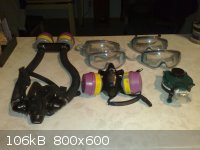
In order left to right. My primary respirator with extension hoses and acid gas cartridges. Next my backup respirator same cartridge, finally my
emergency bailout I keep on my belt when I even open the cyanides for uses, again acid gas cartridge. The small plastic bag is covering the
mouthpiece. I also have an airline adaptor hooked to an oilless compressor in the lab that provides air from an outside intake and mates to both the
respirators (not shown, I'm protective about my lab) . It makes it much easier to wear these long term as it takes more effort to inhale through the
cartridge. Tethering yourself can also be a problem though. All the goggles are vented/sealed, there are gaskets sealing to your face but with vents
at the bottom. Often my gear watering hole has the whole package on sale cheaper than a new faceplate (which is replaceable). So I have about a dozen
pairs.
Respirators are made by http://www.northsafety.com/
The bailout respirator is made by http://www.aosafety.com
The glasses are made by http://www.uvex.com/. It's all stuff that can be had in pretty much every major city and can be had for under 30 bucks for the basic mask and
cartridge. There is no excuse for not wearing/having protection you don't need ebay to get it and no one is gonna ask you funny questions at any place
that sells these.
When in doubt gear up. It's a totally different ballgame when your doing things indoors. If you have protection and the house is empty (or in my case
boot the dog into a room with open windows) NO2 leaking from apparatus is a minor annoyance rather than a lethal problem (with this gear I can't smell
acid gasses and they can't hurt me, there is no fear, my plastic clad eyes often bump the glassware). Same goes for eye protection if your only gear
is a battered face shield your not going to use it.
Backups are also a good idea if something goes wrong as sometimes happens to the most prepared Scientist. Covered in say nitric/sulphuric acid mix you
step into a deluge shower strip contaminated gear, don new gear and (still dripping water) close down the reactions safely(no it's never happened stop
looking at me like that). The alternative is be immediately blinded or dead right off the bat or with your remaining good eye and 23% remaining lung
function throw baking soda and run.
Lookup safety equpiment depending where you are your local home depot may even stock acid gas cartridges with there 3m respirators.
[Edited on 13-2-2011 by Regolith]
|
|
|
hkparker
National Hazard
   
Posts: 601
Registered: 15-10-2010
Location: California, United States
Member Is Offline
Mood: No Mood
|
|
The reason I said two step process is because thats the only way i've seen it done and I didnt know if the reaction would carry out the same at those
lower pressures, but if someone has done it before that way successfully yhen by all means I would recommend it. I just didn't wants to recommend
something if I wasnt totally sure it would work.
My YouTube Channel
"Nothing is too wonderful to be true if it be consistent with the laws of nature." -Michael Faraday
|
|
|
sabbath06
Harmless

Posts: 10
Registered: 17-8-2010
Member Is Offline
Mood: No Mood
|
|
Wow thanks for all of the thoughtful replies. Will be more mindful of my notation in the future. I do not as of yet have a source of vacuum but am
working on that. I am considering postponing the nitric acid distillation until I am better equipped (respirator) and try distilling some glacial
acetic acid from sulfuric acid and sodium acetate.
|
|
|
MrHomeScientist
International Hazard
    
Posts: 1806
Registered: 24-10-2010
Location: Flerovium
Member Is Offline
Mood: No Mood
|
|
So it sounds like distilling nitric acid requires an all-glass setup? I have the simple distillation kit seen here http://www.hometrainingtools.com/distillation-apparatus-kit/... that has rubber stoppers connecting everything.
I tried distilling nitric once using battery electrolyte, but I only got extremely weak acid (it took days to react with a piece of copper to make a
very, very pale blue solution). I suspect that's due to the sulfuric acid being dilute, so a lot of water came over. I also used ammonium nitrate, but
I've been told that can decompose so that probably lowered the yield as well. I concentrated some acid to 15M and was going to try again, but it
sounds like that might destroy my stoppers. Any suggestions?
|
|
|
Regolith
Hazard to Self
 
Posts: 73
Registered: 4-2-2011
Location: Mining the moon.
Member Is Offline
Mood: Glacial
|
|
The only thing more dangerous than regular acid is boiling acid. At high temps the energy of reaction is lowered, or rather has it already present.
Once when concentrating sulphuric acid I put a stopper on the flask to prevent air contact but the acid was still gassing off without my notice. With
no heat source just residual it ate the sides of the stopper till it was thin enough to fall in. Then consumed it utterly, there was small fish tank
gravel sized pieces of carbon left and that's it. On the upside it was one of the last rubber stoppers. I have all PTFE now. Which is your only option
as well, replace the rubber with Teflon.
|
|
|
Zinc
Hazard to Others
  
Posts: 472
Registered: 10-5-2006
Member Is Offline
Mood: No Mood
|
|
I will soon get a 250ml distillation flask, but it doesn't have a ground glass neck so I can't close it with a ground glass stopper. As I would like
to use it for HNO3 making, what could I use to seal the flask? Maybe an Al stopper could somehow be improvised? I thought perhaps even several layers
of Al foil could work (provided it fits tightly to the flask)?
|
|
|
Regolith
Hazard to Self
 
Posts: 73
Registered: 4-2-2011
Location: Mining the moon.
Member Is Offline
Mood: Glacial
|
|
Interestingly several metals can be used for very concentrated acid where they are eaten in more dilute concentrations. Aluminum has good resistance,
I'm worried though because it's foil the acid could get into the layers where it has extreme surface area to chew on/form acid resistant oxides.
Stainless steel is good right through almost the range. Lead interestingly is used for mixed acid the very concentrated acid forms either an oxide or
a nitrate layer that itself isn't soluble in the concentrated acid. I would try the aluminum method if there is no other option, have your bicarb
standing by and breathing protecting for if it goes pear shaped suddenly.
|
|
|
Regolith
Hazard to Self
 
Posts: 73
Registered: 4-2-2011
Location: Mining the moon.
Member Is Offline
Mood: Glacial
|
|
Gratuitous nitric acid distillation photos follow. Using vacuum ready glassware and a vacuum source, ventilation isn't required. The lowered boiling
point and no breakdown or waste of the acid product means pure selection of water content can be managed through careful temperature regulation. A
sealed compressor lets me pipe all the output from the glass outside.
I needed to recycle more than one leftover nitrate source (roughly 6 mols I calculated). I added 500ml, approximately 8 mols of concentrated sulphuric
acid and distilled thusly. Using a scrap compressor fresh from an air conditioner
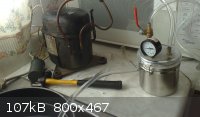
Pull out all the air and it boils at temps that can't even scald you.
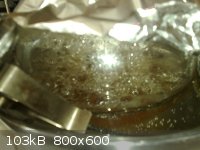 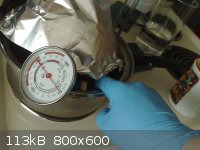
Once you have lowered the boiling point way below the decomposition temperature the output isn't angry red fumes its all nice clear acid steam.
However you need keep a close eye on the temp so as to stop the distillation before you start to pull water across with your anhydrous nitric.
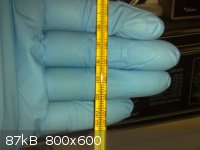 
My output hose just outside the window and because of the good scrubbing solution in my vacuum bottle there isn't even red gassing outside. I'm still
glad this is outside however. Finally the beautiful crystal clear anhydrous nitric acid. This was neutralized with the baking soda behind to just
slightly acidic and boiled down yielding 508.3 grams of analytical grade sodium nitrate.
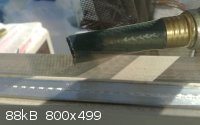 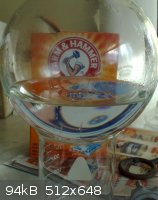
It never occurred to me to photograph the running assembly. Once started I was tied up monitoring and worrying over boiling points. Here's the
glassware after teardown and rinse.
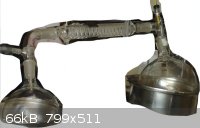
|
|
|
hkparker
National Hazard
   
Posts: 601
Registered: 15-10-2010
Location: California, United States
Member Is Offline
Mood: No Mood
|
|
Great work! That nitric acid looks very clean.
My YouTube Channel
"Nothing is too wonderful to be true if it be consistent with the laws of nature." -Michael Faraday
|
|
|
Arthur Dent
National Hazard
   
Posts: 553
Registered: 22-10-2010
Member Is Offline
Mood: entropic
|
|
@ Regolith: Excellent! What's the stuff you use in your gas scrubber? I have all the stuff needed to do a vacuum distillation, but never tried. Do you
think a plain plastic vacuum water aspirator would do the trick?
I do have a spare air conditioner and I would be tempted to make myself a pump, but for now, my only means of creating a vacuum is this small plastic
water aspirator.
Oh and my only condenser with both ends 24/40 is a liebig... Could I use this? My two graham condensers do not have ground glass joints... 
Robert
--- Art is making something out of nothing and selling it. - Frank Zappa ---
|
|
|
Regolith
Hazard to Self
 
Posts: 73
Registered: 4-2-2011
Location: Mining the moon.
Member Is Offline
Mood: Glacial
|
|
The scrubber is loaded with 1 liter of water 1 mole of sodium carbonate and perhaps 5 grams (a teaspoon) of sodium hydroxide. A plastic fish air stone
breaks up the stream into tiny bubbles greatly increasing the surface area.
A water aspirator should work just fine. Be aware though the distillation can last many hours and if you pay for your water it's gonna get insane
FAST. You've used the device before I assume ? You know to push the output tube down a drain with a trap so as not to get the fumes coming back up?
How long is your Liebig ?(there's a joke there somewhere) I wouldn't try it with less than 300mm (still looking for that joke)you'd get too much acid
missing and ending up in your scrubber(so many jokes...). Plus you would be instantly punished (your scrubber would catch WAY more acid) for having
your coolant temps rise even slightly. You can capture the contents over time then do a recycling run on the scrubber itself.
You could try something else I've been wondering about. At lower temperatures pvc tubing should handle nitric acid vapours. PVC is listed as fair for
slightly elevated temperatures (48C, slight corrosion or discolouration). Considering the still head with good vacuum should be about 35C distilling
nitric. It's feasible you could use thick wall pvc hose to connect to your graham condensers. If your water aspirator can't pull a vacuum hard enough
don't dare force a stopgap like pvc hose though. You should have no part of the apparatus, water bath included go over 48C.
I wonder if an entire nitric acid distillation rig could be made from plastic, PVC or HDPE, and used at very low pressures? Too be sure the product
would likely have contamination, but still interesting chemistry.
|
|
|
Arthur Dent
National Hazard
   
Posts: 553
Registered: 22-10-2010
Member Is Offline
Mood: entropic
|
|
Thanks! 
Good to know, i've been looking into different scrubbing solutions for different gas.
I did not know about the trick of utliising a tube down the drain to avoid gas release... quite logical indeed! Thanks for the advice!
My liebig is exactly 300 mm in its active portion, so i'll use caution and play with modest quantities to start off. And eventually, i'll check-out
Peach's primer on refrigerant compressors to see if I can make myself a nice vacuum device. I thought of using the graham with tubing, but the serious
gases released during that synthesis scare the jeepers out of me. I feel more confident with tightly greased and sealed ground glass joints... 
Robert
--- Art is making something out of nothing and selling it. - Frank Zappa ---
|
|
|
Regolith
Hazard to Self
 
Posts: 73
Registered: 4-2-2011
Location: Mining the moon.
Member Is Offline
Mood: Glacial
|
|
I was going to message you with this Dent but I feel a couple others here could use the knowledge too.
Working with vacuum lowers several danger aspects of distillation and introduces a couple new ones. Vacuum implosion (glass collapses inward at nearly
supersonic speed, collides with the other imploding wall and/or the chemicals being distilled and bounces back outwards again) for example is not
something to mess around with and as long as broken glassware isn't used or stressed glassware that needs annealing, it won't be an issue. Regarding
annealing you'll almost never get this, you'll just find your glassware broken, on its own, after using it for high temp work. As a general rule don't
use your good glassware for anything over 300C, or buy a glass making kiln big enough for your parts.
Don't preheat your solution at all, or VERY slowly turn on your vacuum. Since the boiling point is much lower you may already be at boiling temps
without knowing it and thus have a massive pressure bubble that can blow apart the joints on your glassware and cover you in the contents of the
apparatus. This goes as well if you have a leak and are forced to purge and move something, carefully turn the vacuum back up to allow equilibrium to
return.
Vacuum and or fume leaks aren't an issue if your pump is working right it's SUCKING everything in, any fumes etc that could leak out are being drawn
IN the glassware (another reason for vacuum grease/proper joint sealing) and out the vacuum adapter. Plus in the event of a massive vacuum fail the
increased pressure stops boiling immediately and all the vapour condenses out (some exceptions to that). Distilling sulphuric acid isn't something I
do at standard pressure (if I can help it). The increased safety factor of something failing and the deadly, limb truncating, hot boiling acid,
suddenly stops boiling and won't again until you add hundreds of degrees more heat or pump down the air again.
Keck clips etc are really there for setting up during a vacuum distillation. Once pumped down you can't MOVE any parts in the system let alone have
things fall off. Plus a pressure bubble will send the clips flying with the glassware still attached, I rarely use them, but that's a personal thing.
Which is another point, before vacuum have all your glassware in a position you will be happy with for the next several hours you can't easily change
any of it. Don't have your glassware in a position where it is stressed while pumped down(it's already trying to implode), everything should have been
able to move nicely beforehand no binding joints from something in the wrong place.
Oh and regarding scrubbers NaOH will eat pretty much everything including CO2 right out of the air. Any acid, use something simple like baking soda,
or cook it down to the carbonate(less CO2 gassing off, less pressure disturbance when the scrubber eats something significant). Pure hydroxide in the
scrubber isn't needed and is a bad idea as the scrubber MUST be mounted in a way (bolted to a wall works nicely) as to not have the pump ingest the
contents. I've heard of steam explosions having water aspirators suck up strong acids and bases. Not good times.
|
|
|
Chordate
Hazard to Others
  
Posts: 108
Registered: 23-2-2011
Member Is Offline
Mood: No Mood
|
|
Quote: Originally posted by Regolith  | Had Phone been wearing protection... Well, there might be a face in the coffin.
[Edited on 13-2-2011 by Regolith] |
I thought you were trying to set up some sort of "who was phone?" pun and then I did a search and got sad. Sobering warning. Thanks for the advice on
kit, I rarely get decked out in more than safety goggles, justifying it to myself as "i'm working semimicro under a hood, right? Shouldn't be a
problem". I guess it can always be a problem.
A chap in close to me recently lost half his eyesight in an accident involving a small amount of acetic anhydride and he was nestled snugly in
academia, anything but an amateur.
Its good to be careful.
[Edited on 25-2-2011 by Chordate]
|
|
|
Regolith
Hazard to Self
 
Posts: 73
Registered: 4-2-2011
Location: Mining the moon.
Member Is Offline
Mood: Glacial
|
|
I love telling Phone's story to friends when they ask me if I can make explosives along with all the other science (phone is A reason I don't).
Perhaps my moral compass needs degaussing but I don't find sorrow in what Phone did, quite the opposite I'm glad there's a nice news story to read
with pictures of the devastation in potentia. Same goes for those who end themselves through ignorance in any of the other ways gassing themselves
etc.
To die accidentally (when there was no expectation, proper safety employed etc) is a waste. To be warned over and over again and then remove yourself
in spectacular fashion from the breeding pool through your ignorance, to me is like the ultimate "I told you so". That there sometimes aren't EARS to
hear me say it doesn't change the feeling.
I'm not without sin here either, just today I was making sodium nitrite. The process I used produced significant SO2 gas I had the fume hood running
but for lack of space I was transferring between 2 hoods and got a nose full of fumes. While my respirator was hanging from my neck... A minor
irritated throat that lasted a few minutes and a reminder why you use the gear, not just model it. My excuse was I hadn't powdered
the gaskets on the gear beforehand so it was sweaty and uncomfortable to wear. It was MUCH more comfortable however than feeling my nasal passages
burn.
|
|
|
| Pages:
1
2 |